|
|
|
Sort Order |
|
|
|
Items / Page
|
|
|
|
|
|
|
| Srl | Item |
| 1 |
ID:
075781
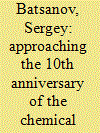

|
|
|
|
|
| Publication |
2006.
|
| Summary/Abstract |
April 29, 2007 will mark the 10th anniversary of the entry into force of the Chemical Weapons Convention (CWC), and it is also the deadline specified in the treaty for completing the destruction of all declared stockpiles of chemical weapons, most of which are owned by the United States and Russia. Unfortunately, it is already clear that neither country will meet the deadline. Although the delay in chemical weapons destruction is a serious problem, in other respects the treaty's bill of health is better than that of the Treaty on the Non-Proliferation of Nuclear Weapons or the Biological and Toxin Weapons Convention. This viewpoint reviews the current status of CWC implementation and looks forward to what might be accomplished at the Second Review Conference in April 2008.
|
|
|
|
|
|
|
|
|
|
|
|
|
|
|
|
| 2 |
ID:
075783
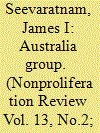

|
|
|
|
|
| Publication |
2006.
|
| Summary/Abstract |
The Australia Group's (AG's) contributions toward stemming global proliferation of chemical and biological weapons of mass destruction over the last 20 years are noted, in addition to the group's complementary role in effectively supporting the purpose and objectives of the Chemical Weapons Convention (CWC). This report also outlines the organizational and operational means that help accomplish the AG mission and notes the U.S. Congress' recognition of the role of the AG in countering chemical and biological weapons proliferation. Addressing criticism by some CWC states parties that question the AG's role in nonproliferation, the author also highlights the AG's expanded reach since September 2001 over terrorist activity. Finally,the article identifies a challenge the AG now faces in furthering its objectives and offers a possible solution.
|
|
|
|
|
|
|
|
|
|
|
|
|
|
|
|
| 3 |
ID:
075780
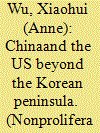

|
|
|
|
|
| Publication |
2006.
|
| Summary/Abstract |
China-U.S. cooperation over the most difficult security problem in Northeast Asia-the North Korean nuclear issue-in essence projects its bigger power game amid the tectonic shifts of Asian geopolitics. The nuclear issue affords a test case to gauge the future posture of China and the United States in East Asia and their partnership in that conflict-prone region. Approaches to resolving this issue must take into account the geopolitical realignment of Asia, Washington's reorientation of relations with its Asian allies, and China's rise as an influential regional player and the subsequent regional response. However, the long-standing mistrust between China and the United States is contributing to a lack of substantial progress in Korean nonproliferation efforts. The declared nuclear test by Pyongyang further put the denuclearization cooperation between China and the Unites States on the line. China-U.S. cooperation in denuclearizing Pyongyang may either produce lasting stability for the region or create ''collateral damage,'' with the North Korean issue paling in comparison.
|
|
|
|
|
|
|
|
|
|
|
|
|
|
|
|
| 4 |
ID:
075775
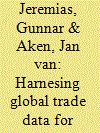

|
|
|
|
|
| Publication |
2006.
|
| Summary/Abstract |
Unlike treaties dealing with nuclear and chemical weapons, the Biological Weapons Convention still lacks formal verification measures, 31 years after entering into force. Here we propose a global export-import monitoring system of biological dual-use items as an additional measure for a web of biological arms controls that could complement traditional export controls. We suggest that such a measure may help to guide consultation or verification processes in the biological area.
|
|
|
|
|
|
|
|
|
|
|
|
|
|
|
|
| 5 |
ID:
075782
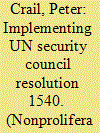

|
|
|
|
|
| Publication |
2006.
|
| Summary/Abstract |
United Nations Security Council Resolution 1540 (UNSCR 1540) was adopted in 2004 to address the risk that non-state actors will acquire weapons of mass destruction (WMD). It requires all states to implement a wide range of domestic legislation to prevent such proliferation. This comprehensiveness makes 1540 an important tool, but a piecemeal approach to implementation may lead to its underutilization. This study provides a risk-based framework, focusing on the implementation of the resolution in a set of states which are the most relevant for WMD proliferation and highlighting a set of 1540 obligations which are the most important for each state to fulfill. An evaluation of implementation progress so far reveals that the vast majority of these states have few of their key obligations in place. While the universal implementation of 1540 is an important goal, ensuring that these key provisions are carried out should be a priority.
|
|
|
|
|
|
|
|
|
|
|
|
|
|
|
|
| 6 |
ID:
075774
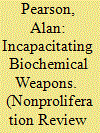

|
|
|
|
|
| Publication |
2006.
|
| Summary/Abstract |
Military interest in incapacitating biochemical weapons has grown in recent years as advances in science and technology have appeared to offer the promise of new "non-lethal" weapons useful for a variety of politically and militarily challenging situations. There is, in fact, a long and unfulfilled history of attempts to develop such weapons. It is clear that advances are opening up a range of possibilities for future biological and chemical weapons more generally. The treaties prohibiting biological and chemical weapons make no distinction between lethal and "non-lethal" weapons-all are equally prohibited. Indeed, a sharp and technically meaningful distinction between lethal and "non-lethal" biological and chemical weapons is beyond the capability of science to make. Thus, interest in incapacitating biochemical weapons, and efforts on the part of various states to develop them, pose a significant challenge to the treaty regimes, to the norms against biological and chemical warfare that they embody, and, ultimately, to the essential protections that they provide. Preventing a new generation of biological and chemical weapons from emerging will take concerted efforts and action at the local, national, and international levels.
|
|
|
|
|
|
|
|
|
|
|
|
|
|
|
|
| 7 |
ID:
075776
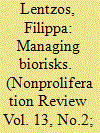

|
|
|
|
|
| Publication |
2006.
|
| Summary/Abstract |
The misuse of biological research is increasingly becoming a prominent policy concern. One regulatory measure that has gained considerable support over the last few years in response to this is voluntary self-governance by the scientific community, and in particular codes of conduct. This article charts the rise of the policy debate on codes, highlighting the involvement of the scientific community. Shifting the focus from policy to practice, it explores the effectiveness of codes of conduct as a regulatory measure by examining our experiences of how another voluntary self-governance regime in the biosciences has worked in practice. Noting limitations with voluntary self-governance as a regulatory tool to prevent misuse, this article includes a reflection on the attention paid to codes of conduct in policy discussions, arguing that there are at least three possible interpretations
|
|
|
|
|
|
|
|
|
|
|
|
|
|
|
|
| 8 |
ID:
075784


|
|
|
|
|
| Publication |
2006.
|
| Summary/Abstract |
This research report explains why safeguards on uranium-ore mines are a theoretically interesting way of dealing with clandestine enrichment facilities, complementing several nonproliferation schemes. A description of mining operations explains how safeguarding mines could fulfill two nonproliferation objectives: ensuring the non-diversion of uranium from mines, and establishing a certified inventory of uranium for use in follow-on material accounting. However, this report also finds that it is essentially impossible to detect undeclared mining, and that this fatal flaw eliminates the ability of safeguards on mines to be useful in addressing the clandestine enrichment problem.
|
|
|
|
|
|
|
|
|
|
|
|
|
|
|
|
| 9 |
ID:
075778


|
|
|
|
|
| Publication |
2006.
|
| Summary/Abstract |
Nuclear terrorism in all its forms is the common enemy of all mankind. Given the emergence of global, non-state terrorism, China must be prepared to confront such threats. A terrorist attack using a functional nuclear device would be devastating. A radiological dispersion device or "dirty bomb" is another form-much less deadly and easier to build than even a crude nuclear device. China believes that to combat nuclear terrorism, it is vital to enhance the security of nuclear materials. Beijing has taken substantial steps in this direction, as well as in increasing the protection of its nuclear facilities, but much work remains to be done, including improving its management and control of radioactive sources and clarifying the design basis threat for critical installations. Ultimately, however, the most effective security will come from strengthening the international nonproliferation and nuclear control regimes.
|
|
|
|
|
|
|
|
|
|
|
|
|
|
|
|
| 10 |
ID:
075777
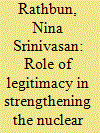

|
|
|
|
|
| Publication |
2006.
|
| Summary/Abstract |
The nuclear nonproliferation regime and its essential foundation, the Treaty on the Non-Proliferation of Nuclear Weapons (NPT), are currently under grave stress. The challenges that have plagued the regime since its inception-universal adherence and the pace of disarmament-persist. But new threats raise questions about the effectiveness of the treaty in preventing the spread of nuclear weapons. These include: clandestine pursuit of nuclear weapons by some NPT parties without the knowledge of the international community and the International Atomic Energy Agency in violation of their obligations; the role of non-state actors in proliferation; and renewed interest in the full nuclear fuel cycle, technology necessary to create fissile material for weapons. This article considers recent prominent proposals to address these three threats and assesses them according to their ability to gain legitimacy, a crucial element in strengthening a regime's overall effectiveness.
|
|
|
|
|
|
|
|
|
|
|
|
|
|
|
|
| 11 |
ID:
075779
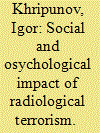

|
|
|
|
|
| Publication |
2006.
|
| Summary/Abstract |
The July 2005 terrorist attacks in London demonstrated the resilience of Western society in the face of low-level conventional terrorism. But the psychological damage from the London bombings would likely pale next to the severe, unpredictable, long-lasting effects of a radiological attack. One unique hazard of radiation exposure beyond the obvious physiological effects is that it is colorless, odorless, and tasteless, making it difficult for ordinary citizens to evaluate, quantify, and rationally understand the dangers confronting them. Radiological weapons stand out among the tools available to terrorists for their capacity to inflict far-reaching psychological damage to civilian populaces well beyond the immediate victims. A possible solution to mitigate the psychological consequences is to build a "resilience culture," an interlocking set of beliefs, attitudes, approaches, and behaviors that help people fare better in any disaster or extraordinary circumstance. The "all-hazards approach," which emphasizes the identifiable similarities among the "disaster triad"-that is, natural, accidentally man-made, and intentionally man-made disasters-extends to acts of terrorism and could help demystify the fears associated with radiological terrorist weapons.
|
|
|
|
|
|
|
|
|
|
|
|
|
|
|
|
|
|
|
|
|